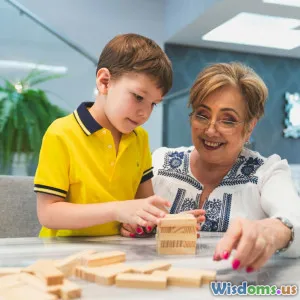
What Happens When Young Adults Stay Home Longer
8 min read Exploring social, economic, and psychological impacts when young adults extend their stay in the parental home. (0 Reviews)
What Happens When Young Adults Stay Home Longer
In recent decades, a significant cultural shift has swept across the globe—young adults are staying in their parents' homes for longer periods after reaching legal adulthood. This trend has sparked widespread debate across social, economic, and psychological domains. But what exactly happens when young adults delay moving out? And what do these effects mean for families, communities, and the individuals themselves?
This comprehensive exploration uncovers the causes, ramifications, and nuanced dynamics of extended co-residence. We’ll shed light on the motivations behind this phenomenon, analyze associated challenges and benefits, and give voices to experts and lived experiences alike.
The Growing Trend of Prolonged Co-Residence
Statistical Landscape
Shockwaves ripple through the traditional milestones of adulthood, especially the rite of passage represented by moving out. According to a U.S. Census Bureau report, in 2020, approximately 52% of young adults aged 18 to 29 were living with their parents—a number more than doubling since 1980, when it was just about 23%. Countries like Italy, Spain, and Greece have reported comparable rates, attributed to socio-economic factors and cultural norms.
Why Are Young Adults Staying Home Longer?
Several forces contribute to this trend. Economic pressures stand paramount. Skyrocketing tuition fees, stagnant wages, and a competitive job market mean many struggle to achieve the financial independence required to afford rent or mortgages. Additionally, societal factors such as increased urbanization and dynamic job markets necessitate flexible living arrangements.
Research published in the Journal of Marriage and Family illustrates that young adults turn to the parental home as a strategic refuge—sometimes temporarily—during times of transition such as post-college or after job loss.
Economic Implications
Financial Relief and Growth Opportunities
Living at home often provides young adults a vital financial cushion, enabling them to save a significant portion of their income. This can lead to reduced debt burdens, particularly student loans, and improved credit profiles. For example, a 2021 study by Pew Research found young adults living at home saved an average of 20-30% more annually than peers living independently.
Strain on Parental Finances
However, the extended stay can exert financial stress on parents as well. Homeowners bear increased utilities, food consumption, wear-and-tear costs, and may need to delay retirement or career changes due to support obligations. The economic recession during the COVID-19 pandemic amplified these issues, with many families facing simultaneous financial hardship.
Psychological and Emotional Dimensions
Benefits of Emotional Support
Close familial living arrangements can reinforce emotional bonds. Many young adults benefit from parental advice, stability, and guidance—which can foster resilience and confidence. Psychologist Dr. Lisa B. Neff remarks, “A supportive home environment bolsters mental health, especially amidst economic uncertainty.”
Challenges: Autonomy and Identity
However, cohabitation may sometimes hinder the development of autonomy, a critical developmental milestone. Young adults report feelings of frustration stemming from perceived parental control or lack of privacy. According to Erin Lentz, a family therapist, “Balancing dependence with independence demands open communication and boundary-setting.”
Social and Cultural Impacts
Changing Notions of Adulthood
Extended residency at home redefines adulthood in contemporary society. Classic markers such as living alone, financial self-sufficiency, and starting one’s family are no longer universally sequential or feasible. Sociologist Arlie Russell Hochschild observes this reflects broader shifts toward a "delayed adulthood" driven by complex economic and cultural realities.
Community and Housing Markets
This trend affects rental and housing markets, particularly in urban centers. Decreased demand for affordable rentals by young adults modifies neighborhood demographics and local economies. In Japan and parts of Europe, "parasite single" phenomena influence marketing, transportation planning, and social services.
Real-World Examples
Case Study: United States
Take the tech hubs like San Francisco and New York City, where sky-high rents and cost of living push young professionals to remain with parents longer. A survey by Zillow in 2022 showed 60% of millennials considered moving back home post-pandemic to save money.
Case Study: Southern Europe
In Italy, where strong family ties and historical cultural norms already support multigenerational living, about 75% of young adults aged 25-34 live with parents. Here, staying home longer is less stigmatized and often embraced as a family-strengthening practice.
How Families Can Adapt
Communication as the Cornerstone
Open dialogues about expectations, goals, and responsibilities become vital. Establishing mutual understanding aids in reducing conflicts and promoting healthy boundaries.
Encouraging Financial and Personal Growth
Parents can assist through financial literacy education, encouraging job hunting, or supporting independent decision-making.
Creating a Balanced Home Environment
Sharing chores, respecting privacy, and fostering everyone's hobbies and social lives help mitigate tensions.
Conclusion: A Complex but Manageable Shift
The phenomenon of young adults staying longer at home encapsulates economic realities, psychological nuances, and cultural transformations. While it offers crucial benefits like financial support and strengthened emotional bonds, it also brings challenges regarding independence and family dynamics.
Rather than demonizing or romanticizing the trend, societies, policymakers, and families must craft supportive frameworks promoting growth and well-being. By acknowledging diversity in individual paths and embracing adaptable family models, we can convert prolonged co-residence from a stigma into an opportunity for enhanced resilience and mutual support.
Ultimately, young adults and their families navigate an evolving life chapter—one that requires empathy, flexibility, and proactive strategies to thrive in the 21st century world.
References:
- U.S. Census Bureau, 2020 American Community Survey
- Pew Research Center, “Young Adults and Living Arrangements,” 2021
- Journal of Marriage and Family, 2019 study on residential transitions
- Psychological insights from Dr. Lisa B. Neff (Harvard Health Publishing)
- Sociological insights from Arlie Russell Hochschild, University of California
- Zillow Rental Trends Survey, 2022
- Italian National Institute of Statistics (Istat), 2020
This article is intended to inform and inspire readers to better understand the evolving dynamics of young adulthood and home life.
Rate the Post
User Reviews
Popular Posts




















